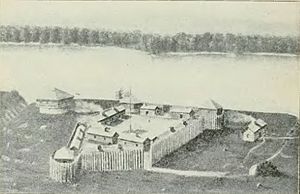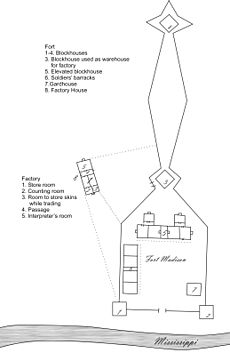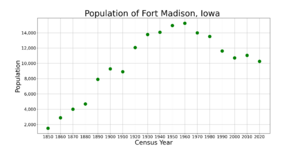Fort Madison, Iowa facts for kids
Quick facts for kids
Fort Madison, Iowa
|
|
|---|---|
|
City
|
|
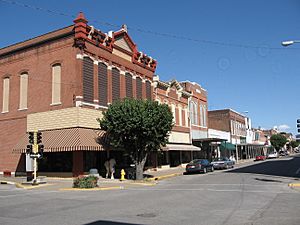
Downtown Fort Madison (2007)
|
|
| Motto(s):
"Always Moving"
|
|
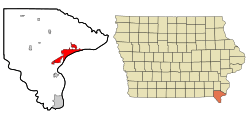
Location within Lee County and Iowa
|
|
| Country | United States |
| State | Iowa |
| County | Lee |
| Founded | 1835 |
| Government | |
| • Type | Mayor-Council |
| Area | |
| • Total | 13.24 sq mi (34.29 km2) |
| • Land | 9.64 sq mi (24.98 km2) |
| • Water | 3.60 sq mi (9.32 km2) |
| Elevation | 525 ft (160 m) |
| Population
(2020)
|
|
| • Total | 10,270 |
| • Density | 1,064.91/sq mi (411.16/km2) |
| Time zone | UTC-6 (Central (CST)) |
| • Summer (DST) | UTC-5 (CDT) |
| ZIP code |
52627
|
| Area code(s) | 319 |
| FIPS code | 19-28605 |
| GNIS feature ID | 0456689 |
Fort Madison is a city in Lee County, Iowa, in the United States. It is one of two county seats in Lee County, along with Keokuk. This is special because Lee County is the only county in Iowa with two county seats.
In 2020, about 10,270 people lived in Fort Madison. The city is located along the Mississippi River in the southeast part of Iowa. It sits between small hills next to one of the widest parts of the river.
Contents
History of Fort Madison
Fort Madison was first built as a U.S. military fort in the upper Mississippi River area. Today, you can see a copy of the old fort along the river. For many years, Sheaffer Pens were created and made here.
The city is also home to the Iowa State Penitentiary, which is the state's highest-security prison for men. Fort Madison is a stop for Amtrak's Southwest Chief train, which crosses the Mississippi River here. The Fort Madison Toll Bridge is one of only two double swing-span bridges left on the Mississippi River. It has a top level for cars and a lower level for trains.
The Fort Madison Downtown Commercial Historic District has many old shops from the late 1800s. There's also the Park-to-Park Residential Historic District. This area has seven blocks of homes built in styles like Gothic, Victorian, and Tudor. It is listed on the National Historic Registry.
The First Fort Madison (1808–1813)
The city of Fort Madison grew around the original Fort Madison, which was built between 1808 and 1813. This was the first lasting U.S. military fort on the Upper Mississippi River. It was also where Black Hawk fought his first battle against U.S. troops. This was the only major battle of the War of 1812 fought west of the Mississippi River. The fort was named after James Madison, who was the fourth President of the United States.
The U.S. Army built Fort Madison to help control the new lands gained from the Louisiana Purchase. It was meant to manage trade and keep peace with Native American tribes in the Upper Mississippi River area. Two other forts, Fort Belle Fontaine and Fort Osage, were built for similar reasons.
Where the Fort Was Built
In 1804, a treaty with the Sauk and other tribes gave the U.S. control over parts of what is now Iowa. To show this control, the U.S. Army wanted to build a fort near the Des Moines River. This river was an important trade route.
They looked for a good spot but didn't find one near the Des Moines River. They also checked land near a Sauk and Meskwaki village. Finally, the Army chose a spot a few miles upstream, where the city of Fort Madison is today.
The fort was first called Fort Belleview. However, it was not in a good location. It was at the bottom of a hill next to a deep ditch. This meant enemies could easily shoot at the fort from above. Native Americans, especially the Sauk, were not happy about the fort. They felt the 1804 treaty was not fair. They also thought American trade goods were not as good as French or British ones. Black Hawk, a Sauk leader, wrote about how much he disliked the new fort.
Attacks on the Fort
Almost from the start, the fort was attacked by the Sauk and other tribes. U.S. soldiers were often bothered when they left the fort. In April 1809, an attempt to storm the fort was only stopped by the threat of cannon fire.
Over time, the fort was made stronger. The walls were made taller, and parts of the fort were extended to a nearby hill for better protection. More blockhouses were built outside the main fort. But these changes couldn't fully fix the fort's bad location. In March 1812, the fort was attacked again. A big siege happened in September of that year. The fort was almost taken over, and many buildings were damaged. The attack ended when cannon fire destroyed a strong Native American position. Black Hawk was part of this siege and said he shot down the fort's flag.
Final Siege and Leaving the Fort
As the War of 1812 continued, British-allied Sauk and other tribes tried to push out the Americans. They wanted to take back control of the upper Mississippi. In July 1813, attacks on soldiers outside the fort led to another long siege. It was so dangerous that the Army couldn't even get the bodies of soldiers killed outside the fort. Troops also couldn't leave to gather firewood. The Army had to burn some of its own buildings so they wouldn't fall into enemy hands.
After weeks of being trapped, the Army finally left the fort. They burned it as they left. They escaped in the dark through a trench to the river, where they got on boats. The exact date they left is not known. Black Hawk saw the ruins soon after. He said, "We were pleased to see that the white people had retired from the country."
A federal fur trade station had been set up at Fort Madison in 1808. It was burned down in 1812 by military order. This was done to prevent it from putting the fort in danger.
Fort Ruins and Discoveries
Early settlers built their homes near the fort's ruins. They named their new town Fort Madison after the old fort. In the early 1900s, a large monument was put up at the fort's location.
In 1965, during construction at the Sheaffer Pen Company factory, archaeologists found parts of the fort. They uncovered the central blockhouse and the foundations of officers' living areas. This site was added to the National Register of Historic Places in 1973. A copy of the fort was built a few blocks away. Many volunteers, including inmates from the nearby Iowa State Penitentiary, helped build it.
Protecting the Fort Site
Today, people are working to protect the original fort site. After the Sheaffer Pen factory closed in 2007, the land was sold. People who want to preserve history say Fort Madison is "Iowa's most important historical site." They want to turn the old parking lot into a park to honor the soldiers who died at the fort. So far, no final plan has been agreed upon.
Starting the Town of Fort Madison
The first person to settle near the fort's ruins was General John Holly Knapp in 1832. He bought some land and built the first building, which was an Indian Supply Store. His cousin, Nathaniel Knapp, and other settlers joined him the next spring. In June 1835, General Knapp and Nathaniel Knapp officially planned out the town of Fort Madison. Because of some land ownership issues, the town was officially moved to the same spot by the government in 1840.
Geography
Fort Madison covers about 13.23 square miles (34.29 km2). Most of this is land, with about 3.74 square miles (9.69 km2) being water.
The city is known for several fun events. These include the Tri-State Rodeo, RiverFest, Mexican Fiesta, Balloons Over the Mississippi, Art in Central Park, and the Annual Lighted Parade.
Climate
| Climate data for Fort Madison, Iowa (1991–2020 normals, extremes 1893–present) | |||||||||||||
|---|---|---|---|---|---|---|---|---|---|---|---|---|---|
| Month | Jan | Feb | Mar | Apr | May | Jun | Jul | Aug | Sep | Oct | Nov | Dec | Year |
| Record high °F (°C) | 67 (19) |
71 (22) |
84 (29) |
93 (34) |
95 (35) |
104 (40) |
107 (42) |
104 (40) |
100 (38) |
92 (33) |
81 (27) |
70 (21) |
107 (42) |
| Mean daily maximum °F (°C) | 32.8 (0.4) |
37.5 (3.1) |
49.9 (9.9) |
62.2 (16.8) |
72.3 (22.4) |
81.5 (27.5) |
85.1 (29.5) |
83.8 (28.8) |
77.1 (25.1) |
64.2 (17.9) |
49.7 (9.8) |
37.6 (3.1) |
61.1 (16.2) |
| Daily mean °F (°C) | 24.8 (−4.0) |
29.2 (−1.6) |
40.8 (4.9) |
52.4 (11.3) |
63.1 (17.3) |
72.5 (22.5) |
76.3 (24.6) |
74.7 (23.7) |
67.1 (19.5) |
54.7 (12.6) |
41.3 (5.2) |
30.2 (−1.0) |
52.3 (11.3) |
| Mean daily minimum °F (°C) | 16.9 (−8.4) |
20.9 (−6.2) |
31.6 (−0.2) |
42.5 (5.8) |
53.8 (12.1) |
63.4 (17.4) |
67.5 (19.7) |
65.6 (18.7) |
57.2 (14.0) |
45.2 (7.3) |
32.8 (0.4) |
22.7 (−5.2) |
43.3 (6.3) |
| Record low °F (°C) | −23 (−31) |
−21 (−29) |
−11 (−24) |
11 (−12) |
22 (−6) |
41 (5) |
47 (8) |
42 (6) |
31 (−1) |
15 (−9) |
−5 (−21) |
−19 (−28) |
−23 (−31) |
| Average precipitation inches (mm) | 1.69 (43) |
1.93 (49) |
2.72 (69) |
3.97 (101) |
5.11 (130) |
5.16 (131) |
4.06 (103) |
3.80 (97) |
3.51 (89) |
3.06 (78) |
2.43 (62) |
1.92 (49) |
39.36 (1,000) |
| Average snowfall inches (cm) | 6.1 (15) |
4.6 (12) |
1.7 (4.3) |
0.5 (1.3) |
0.0 (0.0) |
0.0 (0.0) |
0.0 (0.0) |
0.0 (0.0) |
0.0 (0.0) |
0.1 (0.25) |
0.8 (2.0) |
4.3 (11) |
18.1 (46) |
| Average precipitation days (≥ 0.01 in) | 8.1 | 8.2 | 9.7 | 11.6 | 12.5 | 10.4 | 9.3 | 8.5 | 7.4 | 8.9 | 8.2 | 8.0 | 110.8 |
| Average snowy days (≥ 0.1 in) | 4.0 | 2.9 | 1.3 | 0.2 | 0.0 | 0.0 | 0.0 | 0.0 | 0.0 | 0.1 | 0.5 | 2.8 | 11.8 |
| Source: NOAA | |||||||||||||
People of Fort Madison
| Historical population | |||
|---|---|---|---|
| Census | Pop. | %± | |
| 1850 | 1,509 | — | |
| 1860 | 2,886 | 91.3% | |
| 1870 | 4,011 | 39.0% | |
| 1880 | 4,679 | 16.7% | |
| 1890 | 7,901 | 68.9% | |
| 1900 | 9,278 | 17.4% | |
| 1910 | 8,900 | −4.1% | |
| 1920 | 12,066 | 35.6% | |
| 1930 | 13,779 | 14.2% | |
| 1940 | 14,063 | 2.1% | |
| 1950 | 14,954 | 6.3% | |
| 1960 | 15,247 | 2.0% | |
| 1970 | 13,996 | −8.2% | |
| 1980 | 13,520 | −3.4% | |
| 1990 | 11,618 | −14.1% | |
| 2000 | 10,715 | −7.8% | |
| 2010 | 11,051 | 3.1% | |
| 2020 | 10,270 | −7.1% | |
| Iowa Data Center | |||
Population in 2020
In 2020, Fort Madison had 10,270 people living in 4,315 households. The city had about 1,065 people per square mile. Most residents (86%) were White. About 4.4% were Black or African American, and 6.2% were Hispanic or Latino.
The average age in the city was 42.2 years old. About 23% of residents were under 20 years old.
Economy
The W.A. Sheaffer Pen Company started in Fort Madison in 1907. Its founder, Walter A. Sheaffer, invented a special kind of fountain pen in the back of his jewelry store. Millions of pens were made here. The company was sold in 1997 and the factory in Fort Madison closed in 2006. The Sheaffer Pen Museum in Fort Madison shows many of the company's writing tools.
Arts and Culture
Every year, after Thanksgiving, there's an annual Parade of Lights. Floats sponsored by local businesses are lit up and then displayed in Riverside Park until after New Year's Day.
The North Lee County Historical Society takes care of many historic places in Fort Madison:
- The BNSF double-decker swing bridge was the longest of its kind in the world when it was built in 1927. It is 3,140 feet long.
- The North Lee County Courthouse is the oldest active courthouse in Iowa. It was built in the 1840s.
- The North Lee County Jail was built in 1867 and was used as a small jail until the 1970s. Now, you can take tours there on Beggars Night during Halloween.
- Brush College was built in the mid-1800s to replace an older one-room school.
- The historical society also looks after the old Chicago, Burlington and Quincy Railroad Depot and a Atchison, Topeka and Santa Fe Railway caboose and steam train.
Education
Fort Madison has a campus for Southeastern Community College (Iowa).
The Fort Madison Community School District runs the public schools. It has two elementary schools (Richardson and Lincoln), one middle school (Fort Madison Middle School), and one high school (Fort Madison High School). Part of the city is also in the Central Lee Community School District.
Fort Madison also has Holy Trinity Catholic Schools. This system was formed in 2005 when Aquinas Schools in Fort Madison joined with West Point Catholic schools. Holy Trinity High School includes both junior and senior high students. Holy Trinity Elementary School is in West Point, Iowa, a few miles away.
Getting Around
Amtrak, the national passenger train system, has a station in Fort Madison. The Southwest Chief train stops here daily, traveling between Chicago, Illinois and Los Angeles, California. Fort Madison is the only stop for the Southwest Chief in Iowa. The train crosses the Mississippi River on the Fort Madison Toll Bridge just east of town. This bridge, owned by the BNSF Railway, is the world's longest swing bridge. It carries cars on its upper deck and trains on its lower deck, connecting Fort Madison to Niota, Illinois.
Besides Amtrak, two other railroads serve Fort Madison: the BNSF (Burlington Northern Santa Fe) and Union Pacific.
Greyhound Bus Lines also stops in Fort Madison to pick up or drop off passengers.
US Highway Business 61 and State Highway 2 run through the center of the city, following the river and train tracks. A new bypass for US Highway 61 around Fort Madison opened in 2011. US Highway 61 connects to other major highways in Iowa, Illinois, and Missouri.
Famous People from Fort Madison
- Black Hawk, a Sauk leader
- Mark W. Balmert, a U.S. Navy admiral
- Ryan Bowen, an NBA basketball player
- James Duderstadt, former President of the University of Michigan
- Todd Farmer, a writer, actor, and film producer
- Patty Judge, former Lieutenant Governor of Iowa
- Dick Klein, who started the Chicago Bulls basketball team
- Dennis O'Keefe, an actor
- Walter A. Sheaffer, who founded the W.A. Sheaffer Pen Company
Sister Cities
 Prüm, Germany
Prüm, Germany
See also
 In Spanish: Fort Madison (Iowa) para niños
In Spanish: Fort Madison (Iowa) para niños


